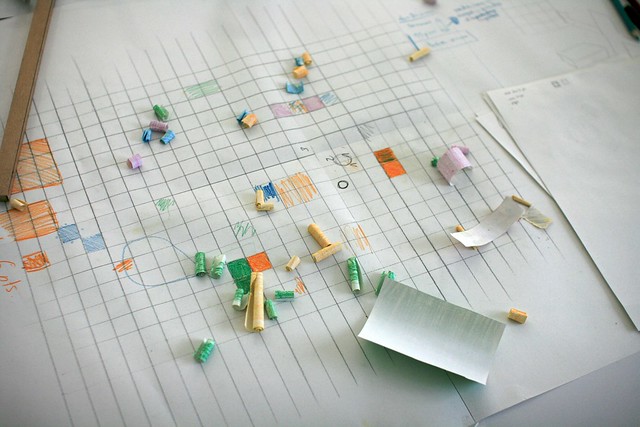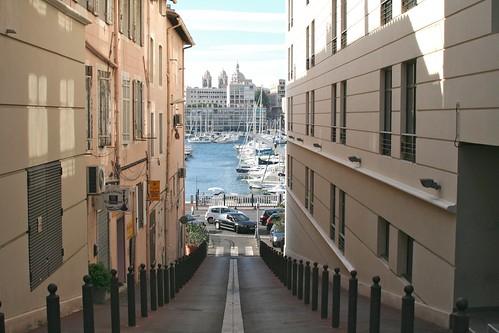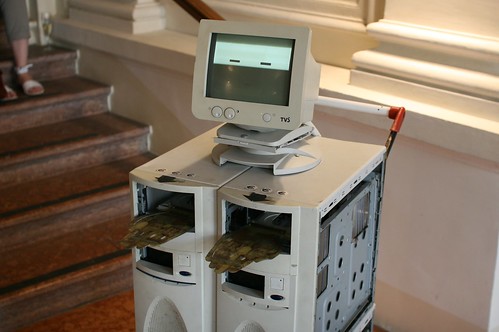Last week, I organized a Lift seminar at Imaginove in Lyon, France. The focus was on user participation and user-generated content in digital industries. The idea was to give attendants an overview of the field, to address recent evolutions and possible futures. Given that I think it's important to have a transversal approach, I invited three persons from different fields. We had Florence Devouard (Wikimedia Foundation Advisory Board member, consultant at Anthere Consulting), Sabine Dufaux (independent Digital Strategist) and Alexis Lang (game designer at AtOnce technologies). The idea was to understand the implications of user-generated content with 3 cases: the Wikipedia, the role of UGC for brands and how the video game industry look at UGC.
The Wikipedia case

Florence Devouard started off with a description of the Wikipedia case. More specifically, her presentation focused on the evolution of participation on Wikipedia, as well as the motivation users have to be engaged in this project.
Understanding usage pattern on Wikipedia is not that easy because people do not necessarily log in (and when they do they use a nickname), they may contribute with different nicknames, sometimes contributions are anonymous and sometimes handled by bots (correction, etc.). Moreover, most of the studies that has been carried out focused on the anglophone wikipedia, which does not account for cultural differences.
That being said, some lessons can be drawn:
- The notion of participation on Wikipedia is broad: participants are not only people who write articles, they can be users who only correct mistakes or individuals involved in fundraising.
- Regarding the participation stats, less than 0.05% of the visitors are active contributors, which is far less than the 1-90-100 law.
- Most of the contributors are male between 18 and 28 years old (students or people having their first job, not married yet and no kids) as well as lots of retired people. The enabling factors are pretty basic: they have time, skills and a will to share content.
- "North" contribute to 81% of the modifications and consultations (although they represent only 18% of the word population). Europeans contribute to 35% of the modifications (and account for 35% of the consultation). North americans take care of 23% of the modifications amd 38% of the consultation.


Interestingly, as shown by the graphs above, the the number of active and very active contributors (those making 5+ edits in a month) peaks after 5–6 years, around 2007 on the anglophone Wikipedia. The reason for this might be that: (1) a sentiment that there's already a lot of content (and hence participation can be more focused on small corrections), (2) the community is less welcoming for newcomers, (3) technical difficulties to editing (and the mediawiki technology is a bit old), (4) social networks put a lot of competitive pressure (in terms of on-line attention from users). That being said, there are clearly some success factors: a clear and engaging vision, a low barrier to participation, good incentives to participation (people are happy to exchange, rewards on user pages, etc.) and a functional governance.
Brands and UGC
Sabine Dufaux (see her slides) followed up on this with a different angle. She address the relevance of user-generated content for brands and the way they communicate. Sabine showed that technological and social conditions are now good enough to provide an abundance of content and participation. These conditions enable a dynamic and collaborative model for which there's a social gain for people in participating, a virtuous circle of some sort.
Sabine also showed that there's a need to go beyond the 1-90-100 law of participation by pointing the "participation ladder" described by Forrester Research:

For brands, this is important and as much as 25% of the content of brands are made of UGC. Technology converted part of the "spectators" into users, which in turn can prescript products and services (only 14% of consumers trust ads, 78% trust recommendations from friends and family). However, ad men seem to have a love and hate relationship with UGC. They know it can lead to success and consumers' engagement but they fear the inherent loss of control. The advantage for brands are clear: create a relationship with people, develop a certain proximity, favor adhesion and recommendation, etc. The risk to loose control is there but it was already present beforehand.
What's interesting is that design can produce gaps and holes that people can fill. These gaps can lead to new form of dialogues between companies and the users of their products.
UGC in the video game industry
Based on various examples from the Role-Playing Game field, Alexis Lang showed first that user-generated has already been there for a while, without technology. RPG were based on a simple pyramid of participation with pros at the top (writers, cartoonists), game masters (who created their own scenarios), players (who created a character and "play" it) and readers/spectators. Content circulated between these different actors and sometimes got published in books, fanzines and magazines.

The advent of the digital media led to other forms of participations in video games: MUDs, level editors (Starcraft + FPS), games such as Little Big Planet or Lego MMO. The new forms of pervasive and location-based games also offer interesting possibilities in terms of user creation. See for example platforms such as Hidden Park, GPS mission or SCVNGR.
Alexis is interesting in how to go beyond these examples and how a relevant narrative can be co-created by a crowd of players (like encyclopedia with Wikipedia). His current project (called "project c") is about designing a collaborative storytelling platform by using design gaps are source of creativity (and narratives). The obvious problem here is both to keep a certain level of quality and coherence. In his project, the history if a jigsaw puzzles: virtual objects (in the form of narrative bits) have to be collected and assembled... and the user-generated content lies in the holes that people have to fill and speculate about (by creating hypotheses).
Why do I blog this? These 3 perspectives are highly insightful. It's curious to see how such a focused topic can be addressed with a different vocabulary and distinct perspectives. However, there are clearly some common trends:
- The success of participation lies in the "gaps" left by designers... and which users can insert their contributions. The size of the gaps can be very wide (the beginning of Wikipedia) or super tiny (typos in Wikipedia, some examples from how brand use UGC).
- The growing importance of mechanisms to orchestrate what is going to sit in these gaps: the curation.
- Time is an important issue as motivation evolves, some spaces are filled and other can be opened
Thanks again to the three participants!
 Lift 12 is almost there... and I will co-organize two workshops there:
Lift 12 is almost there... and I will co-organize two workshops there:








 (A "
(A "